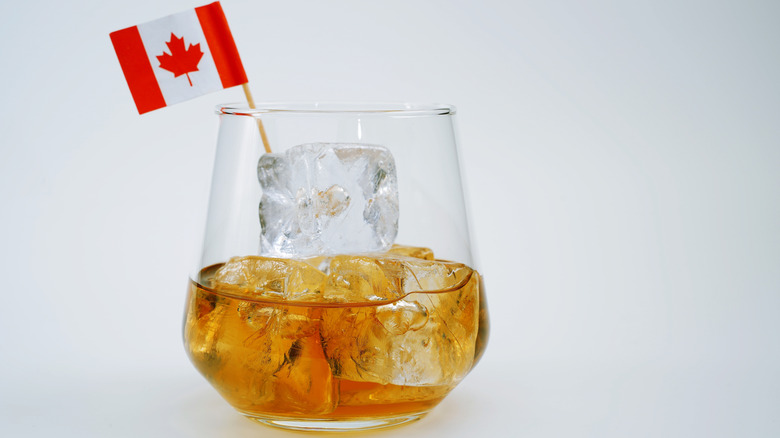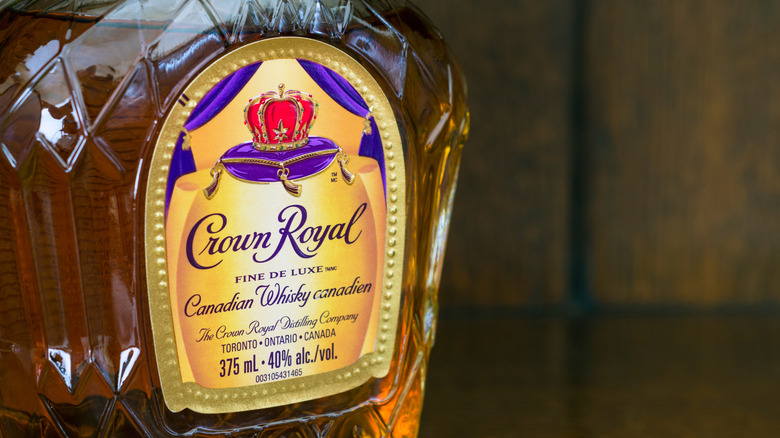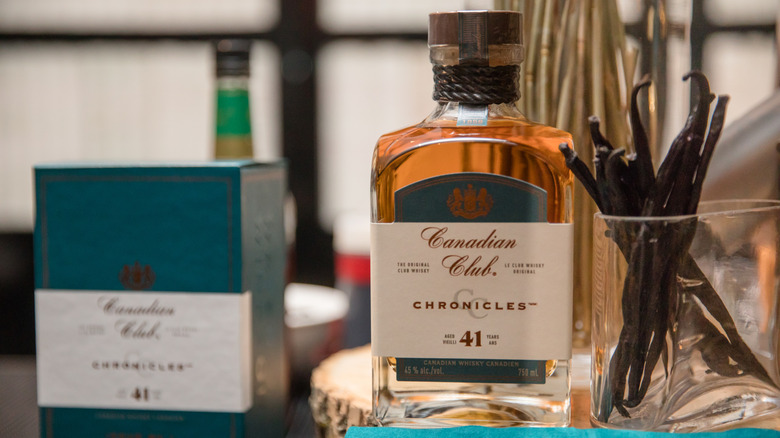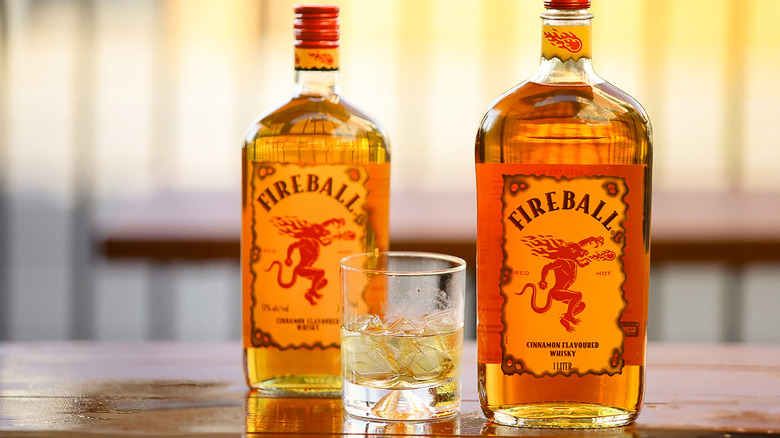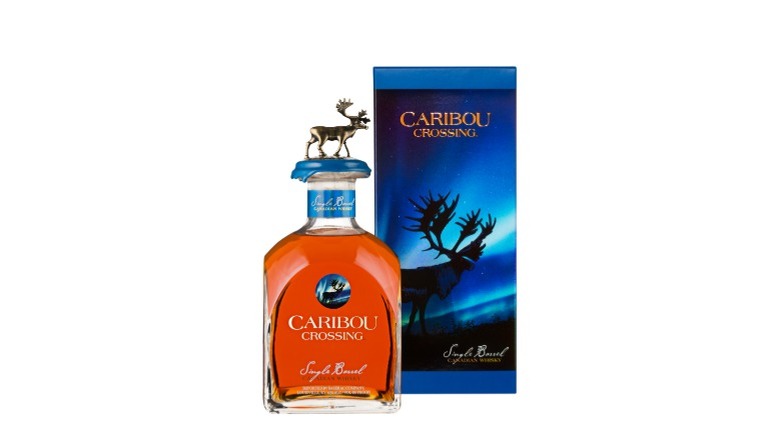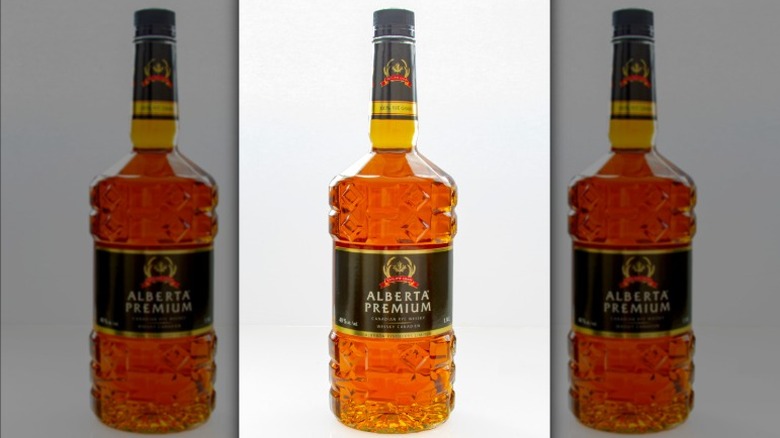5 Canadian Whiskies You Can Buy In The US
Whisky will give you certain visual cues just by looking at it, but it's unlikely that you can tell a Canadian whisky from any other region without tasting it. It's often said that Canadian whiskies are sweeter and have less edge than American varieties: definitely different, although not intrinsically better or worse. Unlike bourbon, or American whiskey, requirements for Canadian whisky (which may occasionally be spelled "whiskey", though whisky and whiskey aren't quite the same) are a bit less-stringent. Canadian whisky must be mashed and distilled in Canada; it must be aged for a minimum of three years in wooden barrels, and the finished product must be at least 40% ABV — those are the only rules.
With several Canadian provinces pulling American spirits off liquor store shelves for trade-based political reasons, maybe you want to either seek out or avoid Canadian whiskes in the United States. While this is not an exhaustive list, the following are some of the major whisky brands from our neighbors up north. It contains some major players that you may have never known were Canadian, along with some brands whose names should have made the matter clear.
Crown Royal
One of the most popular names in whisky today, Crown Royal was created in 1939 as a gift to King George VI and Queen Elizabeth as they made a royal tour stop in Canada. It wasn't even sold in America until the 1960s, but, with its market dominance nowadays, it has clearly made up for lost time. Crown Royal is produced in Manitoba even today, with the lion's share of ingredients coming from the province as well. The label puts out several varieties of whisky, including Crown Royal Black, Crown Royal XR Extra Rare, and Crown Royal Northern Harvest Rye, plus some flavored options.
Pros who know how to taste whisky have said that Crown can be amazing in cocktails. Crown and Coke is an old standby, of course, but many argue that it also shines in a Highball, Manhattan, or an Old Fashioned cocktail when the mood strikes.
Canadian Club
The name is a dead giveaway, right? The company that would eventually become Canadian Club goes all the way back to an Ontario distillery in 1858. It was the first Canadian whisky to brand its barrels with the company name as part of an attempt to assure consumers of its high quality. By the 1880s, American men were sipping the Canadian spirit in gentlemen's clubs, leading to the appellation that we know today.
You might see various bottles of Canadian Club at the liquor store, including Canadian Club 1969, Canadian Club 1976, and Canadian Club 1858 — the latter labeling is the newest-year's offering. You can tell the different whiskeys apart by their color, which ranges from pale amber to a reddish-gold hue, as well as their distinct flavors. All Canadian Club whiskies lend themselves well to mixing, with clean profiles and light tastes.
Fireball
Is Fireball actual whiskey? That's an interesting question: "Fireball Cinnamon" is technically considered a malt beverage due to its low ABV, while the OG, "Fireball Whisky," is the real deal. When you were getting your sinuses fried in college by the astringent cinnamon-y kick of Fireball, you probably didn't notice the missing "e" that gave away its Canadian origins ... remember that "whiskey" and "whisky" are not the same! Some say that Fireball was created by a Canuck bartender as a way of getting through the frigid winters. Whether that is true or not, Fireball is definitely a young company, as it was just founded in the 1980s.
Futhermore, Fireball, which was originally named "Dr. McGillicudy's Fireball Whisky," didn't migrate over the border until 2001. College parties have never been the same. Fireball is often drunk straight, usually as a shot. It can be mixed as well: for instance, when swirled with apple cider, it becomes an apple pie shot.
Caribou Crossing
Again, the name tells a story. The first-ever single barrel Canadian whisky, Caribou Crossing is a product of the Sazerac liquor conglomerate. Its bottles are decorated with a super-cool golden caribou on top, just in case you want to display your Canadian pride on the shelf. Sazerac brands Caribou Crossing as a premium whisky option, with the pricing to match. Its barrels age for at least a decade, leading to a complex yet easy-sipping spirit that many fans say is great for drinking neat — although, some claim a splash of distilled water makes for a better whisky-tasting experience.
There isn't as much literature on Caribou Crossing as with other entries on this round-up, as Caribou Crossing seems to be a newer offering. However, repeated reviews mention the extremely smooth taste, which can be a pro or a con, as some whisky drinkers prefer a bit of a burn.
Alberta Premium
Once again, the name gives away the mystery. Alberta Premium holds the distinction of being the Canadian whisky gold medalist in the 2024 International Spirits Challenge. It's the world's bestselling 100% rye whisky. The company has been around since 1946, but it has only recently been allowed to cross the border and be sold in the United States, to the great delight of American whiskey enthusiasts. Alberta, being mountainous, gives life to a different kind of whisky than the spirits distilled in Ontario, due to differences in climate and natural resources. It's these unique aspects that give so much character to the whiskies sold by Alberta Premium.
Clearly, Alberta Premium is a spirit that demands respect. To that end, it's intended as a sipper. Whether you sip whiskey neat or on the rocks is a matter of personal preference, no matter what self-described "experts" will try to claim.
